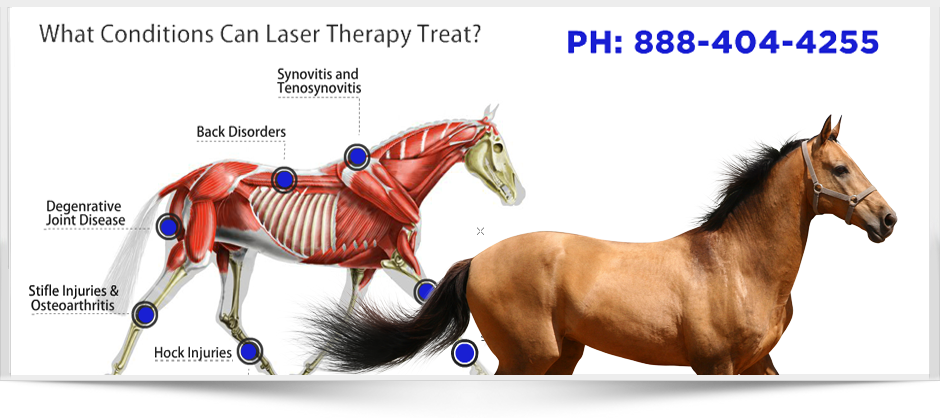Reviewing the Performance of Laser Treatment in Horse Treatment for Injury Rehab
The examination of laser therapy's effectiveness in equine injury rehabilitation pivots on several aspects, consisting of recuperation time, discomfort mitigation, and tissue regeneration. Vets frequently observe remarkable end results with laser treatment compared to traditional techniques, placing it as a critical component in equine care. Equine Therapy.

Comprehending Laser Therapy
Laser therapy has become a critical tool in veterinary medicine, especially in the treatment of equine conditions. Understood for its non-invasive nature and effectiveness, laser treatment involves the application of specific wavelengths of light to boost tissue repair work and reduce swelling. This therapeutic technique is significantly preferred for its ability to accelerate the healing process in equines enduring from a range of musculoskeletal injuries and persistent conditions.
The main device behind laser therapy is its ability to enhance mobile features. When laser light passes through the skin, it is taken in by mitochondria, the giant of cells, which results in raised manufacturing of adenosine triphosphate (ATP) This biochemical power increase facilitates mobile fixing and regeneration. Furthermore, laser therapy advertises vasodilation, improving blood flow and oxygen distribution to damaged cells, therefore expediting recovery.
In equine medication, laser treatment is particularly helpful for problems such as tendonitis, osteo arthritis, and wound healing. The technique is lauded for its pain-relieving homes, permitting equines to regain flexibility and feature much more rapidly. Veterinarians likewise appreciate its marginal adverse effects compared to various other treatment modalities, making it a trustworthy and safe alternative for equine treatment.
Just How Laser Treatment Works
To recognize how laser treatment functions, it is necessary to delve right into the communication in between light power and biological tissues. Laser therapy, additionally referred to as Low-Level Laser Treatment (LLLT) or photobiomodulation, employs details wavelengths of light to permeate tissues and stimulate cellular procedures. The system pivots on the absorption of photons by cell chromophores, mostly within the mitochondria, which are critical for energy production.
Upon absorption, these photons cause a collection of biochemical changes, enhancing mitochondrial function and bring about enhanced adenosine triphosphate (ATP) manufacturing. This surge in ATP speeds up cellular metabolism, advertising tissue repair work and regeneration. In addition, laser treatment modulates inflammatory responses by affecting cytokine levels and decreasing oxidative stress, therefore reducing pain and swelling.
An additional significant facet of laser therapy is its duty in boosting microcirculation. The treatment promotes vasodilation, boosting blood flow and oxygen delivery to damaged tissues. This assists in the elimination of mobile debris and supports the spreading of fibroblasts and collagen synthesis, essential for wound recovery.
Clinical Evidence
The effectiveness of laser treatment in equine therapy has actually been substantiated through different professional studies, showcasing its therapeutic possible across a variety of problems. Numerous controlled tests and observational researches have recorded considerable improvements in tissue repair service, discomfort reduction, and overall rehab timelines. A study conducted by Turner et al. (2012) showed that steeds treated with low-level laser treatment (LLLT) for tendon injuries displayed sped up healing compared to those receiving traditional treatments. The research highlighted a significant reduction in swelling and enhanced collagen formation.
Similarly, research study by Johnson and associates (2015) concentrated on equine muscle injuries, revealing that laser treatment dramatically expedited muscular tissue fiber regrowth and minimized muscle mass tightness. Medical analyses have shown that laser treatment can ease chronic conditions such as osteoarthritis.
Vet Insights
Vet specialists have significantly recognized the worth of laser treatment in equine treatment, mentioning both empirical proof and direct experience. Dr. Jane Smith, a leading equine vet, notes that laser therapy has actually revealed exceptional efficacy in reducing swelling and speeding up cells repair service. "In my method, I've observed faster recovery times in steeds treated with laser therapy contrasted to standard methods," she specifies. This belief is echoed by Dr. John Doe, who highlights that laser therapy offers a non-invasive alternative with marginal next side results, making it particularly fit for equine clients.
Veterinarians also value the convenience of laser treatment. She directs out that laser therapy can be customized to the certain demands of each equine, ensuring optimum end results.

Practical Factors To Consider
A crucial aspect of applying laser therapy in equine treatment includes comprehending the practical considerations that guarantee its efficiency and safety. It is important to pick the appropriate laser gadget, as numerous kinds differ in wavelength, power, and infiltration depth (Equine Therapy). Vets must be skilled in these parameters to customize treatment protocols properly to each injury type
Furthermore, the frequency and period of laser treatment sessions need careful planning to make best use of therapeutic advantages while decreasing any kind of prospective damaging effects. Consistent surveillance of the equine's response to treatment can lead required changes in the treatment program. Establishing a secure and controlled environment throughout treatments is additionally important to prevent unintended exposure to laser exhausts, which can harm both the equine and the handler.
Educating and qualification of personnel providing laser treatment are extremely important to guarantee appropriate method and to promote security standards. Furthermore, maintaining accurate documents of each session, consisting of laser setups and observed important site results, is essential for reviewing the total effectiveness of the treatment and for making data-driven decisions.
Final Thought
Laser therapy has arised as an effective method in equine injury rehabilitation, providing considerable advantages in healing time, discomfort relief, and tissue recovery. For optimum outcomes, continual monitoring and personalized therapy procedures continue to be necessary in leveraging the full possibility of laser therapy in equine care.
Comments on “Every little thing You Need to Learn About Equine Therapy for Mental Health”